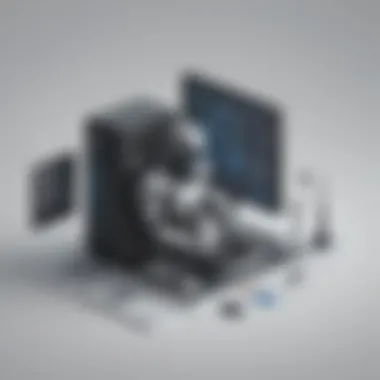Unveiling the Significance of Check Point MDR in Business Technology Evolution


Technological Research Overview
In today's fast-paced digital landscape, technological research plays a pivotal role in driving innovation and progress. Recent technological advancements, especially in the realm of cybersecurity, have revolutionized how businesses operate and interact with technology. The introduction of Check Point MDR (Managed Detection and Response) has particularly influenced business operations by enhancing cybersecurity defenses and overall technological resilience.
When discussing the impact of Check Point MDR on business technology, it is crucial to examine how such innovations have reshaped the cybersecurity landscape. By analyzing recent technological trends, businesses can better understand the importance of staying ahead of cyber threats and embracing solutions that offer proactive threat detection and response capabilities.
Data Analytics in Business
Data analytics has emerged as a critical aspect of modern business operations, enabling organizations to extract valuable insights from vast amounts of data. In the context of Check Point MDR, data analysis plays a key role in identifying potential threats and vulnerabilities within an organization's IT infrastructure.
Implementing Check Point MDR involves utilizing advanced tools for data analysis to detect and respond to cyber threats effectively. By studying case studies of data-driven decisions related to cybersecurity, businesses can gain a deeper appreciation for the role of data analytics in fortifying their defenses and mitigating risks.
Cybersecurity Insights
As businesses navigate an increasingly complex threat landscape, cybersecurity insights have become indispensable for ensuring the protection of critical assets and sensitive information. Conducting thorough threat landscape analyses allows organizations to identify potential vulnerabilities and proactively address security gaps.
Best practices for cybersecurity, especially in the context of Check Point MDR implementation, center around integrating robust security protocols, conducting regular security audits, and fostering a culture of security awareness among employees. Moreover, regulatory compliance in cybersecurity is non-negotiable, as adherence to industry standards and regulations is essential for maintaining a secure business environment.
Artificial Intelligence Applications
Artificial Intelligence (AI) is rapidly revolutionizing business automation and security practices. In the realm of cybersecurity, AI algorithms and applications are increasingly being deployed to enhance threat detection mechanisms and streamline incident response processes.
When considering the implementation of Check Point MDR, businesses must also factor in ethical considerations related to AI usage. Ensuring transparency, accountability, and fairness in AI decision-making processes is essential to maintain trust and integrity in cybersecurity practices.
Industry-Specific Research
Different industry sectors, such as finance, healthcare, and retail, have unique technological research requirements that directly impact their operational efficiency and security posture. For instance, the finance sector heavily relies on cutting-edge technology to secure financial transactions and customer data.
In healthcare, technological advancements are driving improved patient care, data management, and medical research. Retail industries leverage technology solutions to enhance customer experiences, optimize supply chain management, and prevent fraud and security breaches.
By delving into industry-specific research and understanding the technological needs of different sectors, businesses can tailor their cybersecurity strategies to align with industry standards and regulatory requirements.
Introduction
In this comprehensive article, we delve into the intricate world of Check Point MDR (Managed Detection and Response) and its impact on business technology. As businesses navigate the complex landscape of cybersecurity threats and technological advancements, understanding Check Point MDR becomes paramount. This section will highlight the key elements surrounding Check Point MDR, shedding light on its benefits, challenges, and crucial considerations for implementation.
Understanding Check Point MDR


Definition of Check Point MDR
Check Point MDR stands as a pivotal component in modern cybersecurity strategies. It amalgamates cutting-edge technology with proactive threat detection mechanisms, offering businesses a robust defense system. The intrinsic characteristic of Check Point MDR lies in its holistic approach towards identifying and mitigating threats in real-time. This unique feature positions Check Point MDR as a favorable choice for organizations seeking a comprehensive solution to safeguard their digital assets effectively.
Evolution of Managed Detection and Response
The evolution of Managed Detection and Response signifies a paradigm shift in cybersecurity methodologies. From reactive measures to proactive strategies, MDR has revolutionized how threats are handled. The key characteristic of MDR's evolution is its adaptive nature, constantly evolving to counter emerging threats. This adaptability makes MDR a preferred choice for organizations aiming to stay ahead in the cybersecurity game.
Key Components of Check Point MDR
The key components of Check Point MDR form the backbone of its efficacy. These components work synergistically to fortify an organization's security posture comprehensively. Each component brings a unique feature to the table, contributing significantly to the overall threat detection and response capabilities. While these components offer numerous advantages in enhancing cybersecurity resilience, they also pose certain challenges that organizations need to address effectively.
Benefits of Check Point MDR
Enhanced Threat Detection Capabilities
Enhanced Threat Detection Capabilities pave the way for proactive threat identification, allowing organizations to thwart potential attacks before they escalate. This key characteristic serves as a proactive shield against evolving cyber threats. The unique feature of real-time threat monitoring enhances the overall cybersecurity posture, enabling businesses to stay one step ahead of threat actors.
Proactive Incident Response
Proactive Incident Response is instrumental in minimizing the impact of security incidents on an organization. By swiftly addressing potential threats, organizations can mitigate damages effectively. The key characteristic of proactive incident response lies in its agility and effectiveness in handling security breaches. However, balancing proactive response with day-to-day operations poses a notable challenge that organizations must navigate adeptly.
Integrated Security Solutions
Integrated Security Solutions consolidate various security tools into a unified platform, streamlining security operations. This key characteristic simplifies security management, offering a centralized view of the organization's security infrastructure. The unique feature of integration enhances operational efficiency but can introduce complexities in deployment and maintenance.
Challenges in Implementing Check Point MDR
Integration Complexity
Integration Complexity poses a significant challenge during the implementation of Check Point MDR. The intricate web of existing infrastructures requires seamless integration with MDR solutions for optimal performance. While integration enhances overall security capabilities, the complexity involved demands meticulous planning and execution.
Resource Allocation
Resource Allocation stands as a critical factor influencing the successful implementation of Check Point MDR. Allocating the right resources, including skilled personnel and financial investments, is imperative for leveraging MDR effectively. The key characteristic of resource allocation lies in aligning organizational goals with MDR's requirements, ensuring a harmonious integration that maximizes cybersecurity benefits.
Adapting to Evolving Threat Landscape
Adapting to the Evolving Threat Landscape presents an ongoing challenge for organizations implementing MDR. The dynamic nature of cyber threats necessitates constant vigilance and adaptation to emerging risks. The key characteristic of adaptability underscores the need for organizations to stay abreast of the latest threat vectors and mitigation strategies, fostering a proactive cybersecurity environment.


Considerations for Check Point MDR Adoption
Scalability Requirements
Scalability Requirements play a crucial role in determining the efficacy of Check Point MDR implementations. As organizations expand their digital footprints, scalability becomes paramount to accommodate growing security needs. The unique feature of scalable solutions ensures that MDR systems can evolve alongside the organization's changing landscape, supporting sustainable cybersecurity practices.
Compliance and Regulatory Aspects
Compliance and Regulatory Aspects add a layer of complexity to Check Point MDR adoption. Ensuring compliance with industry standards and regulatory requirements is essential for maintaining trust and integrity. The key characteristic of regulatory compliance emphasizes adherence to stringent guidelines, safeguarding sensitive data and mitigating legal risks.
Cost-Benefit Analysis
Cost-Benefit Analysis serves as a fundamental consideration for organizations evaluating Check Point MDR adoption. Balancing the costs associated with implementation against the potential benefits is crucial for making informed decisions. The unique feature of cost-benefit analysis lies in assessing both tangible and intangible returns, enabling organizations to justify investments in cybersecurity without compromising financial stability.
Exploring Check Point MDR in Business Context
As we dive into the intricate realm of Check Point MDR within the business context, it is imperative to grasp the pivotal role it plays in fortifying cybersecurity defenses and technological resilience. By dissecting the tailored defenses Check Point MDR offers, businesses can proactively safeguard their digital assets against a myriad of evolving cyber threats. The amalgamation of cutting-edge technology and strategic foresight through Check Point MDR enables organizations to enhance their cybersecurity posture while ensuring seamless technological operations. The exploration of Check Point MDR in the business context sheds light on the strategic imperatives that underpin modern cybersecurity strategies, emphasizing the need for a proactive and multilayered defense mechanism.
Real-World Applications of Check Point MDR
Case Studies of Check Point MDR Implementation
Delving into the intricate intricacies of Case Studies of Check Point MDR Implementation enhances our understanding of how businesses have successfully leveraged this solution to bolster their cybersecurity defenses. These case studies serve as poignant examples of the efficacy of integrating Check Point MDR into existing security frameworks, showcasing real-world scenarios where proactive threat detection and swift incident response have significantly mitigated potential risks. The unique feature of Case Studies of Check Point MDR Implementation lies in their ability to provide tangible and quantifiable results, offering a transparent view of the direct impact Check Point MDR can have on enhancing an organization's cybersecurity posture. By dissecting these case studies, businesses can glean valuable insights into best practices and strategic approaches for implementing Check Point MDR within their unique operational landscapes.
Impact on Cybersecurity Posture
The Impact on Cybersecurity Posture brought forth by Check Point MDR illuminates the transformative effect it can have on fortifying an organization's defense mechanisms. This aspect delves deep into how Check Point MDR can elevate threat detection capabilities, streamline incident response procedures, and unify security solutions to create a holistic cyber defense framework. By prioritizing the Impact on Cybersecurity Posture, organizations can enhance their resilience against advanced cyber threats, instilling a proactive security stance and fostering a culture of cybersecurity awareness within the workforce. However, it is crucial to weigh the advantages and disadvantages of this impact to ensure that the implementation aligns cohesively with the organization's overarching security objectives.
Business Resilience Enhancement
A critical facet of Check Point MDR lies in its ability to enhance overall Business Resilience by fortifying digital assets, operational continuity, and adaptive security measures. Through innovative technologies and integrated security solutions, Check Point MDR bolsters business continuity plans, mitigates operational disruptions, and fosters a proactive response to emerging cyber risks. The unique feature of Business Resilience Enhancement is its capacity to empower organizations to navigate turbulent cyber landscapes with confidence, enabling them to adapt swiftly to evolving threats and regulatory challenges. However, it is essential to consider the nuanced advantages and disadvantages that come with this enhancement to ensure a seamless integration that aligns with organizational objectives.
Integration with Existing Security Infrastructure
Synergies with SIEM Solutions
Synthesizing the interplay between Check Point MDR and SIEM Solutions offers a comprehensive perspective on the seamless integration of these sophisticated security frameworks. The key characteristic of Synergies with SIEM Solutions lies in their complementary nature, where Check Point MDR enhances threat detection precision while SIEM Solutions provide centralized security event management. By maximizing these synergies, organizations can create a robust security ecosystem that fortifies cybersecurity postures and facilitates swift incident response procedures. However, one must meticulously evaluate the advantages and disadvantages of this integration to ensure operational efficiency and seamless security orchestration.
Endpoint Security Integration


The amalgamation of Check Point MDR with Endpoint Security solutions underscores the significance of securing endpoint devices within a holistic cybersecurity framework. Endpoint Security Integration plays a pivotal role in fortifying devices against advanced cyber threats, ensuring comprehensive threat visibility and proactive incident response capabilities. The key characteristic of this integration lies in its ability to bolster endpoint security protocols without impeding operational efficiency, offering a seamless defense mechanism against evolving cyber risks. While emphasizing the advantages of Endpoint Security Integration, it is imperative to navigate the potential disadvantages to tailor the implementation to align seamlessly with organizational requirements.
Cloud Security Integration
Navigating the complexities of Cloud Security Integration alongside Check Point MDR unravels a realm of secure cloud operational paradigms and resilient data protection measures. The unique feature of Cloud Security Integration lies in its ability to secure cloud environments, streamline data access controls, and fortify cloud infrastructure against cyber intrusions. By leveraging Check Point MDR in tandem with cloud security solutions, organizations can safeguard critical data, ensure compliance with regulatory standards, and optimize cloud security operations. It is essential to analyze the advantages and disadvantages of this integration to establish robust cloud security frameworks that align with business objectives and regulatory mandates.
Future Trends in Check Point MDR
Adoption by Small and Medium Enterprises
Examining the landscape of Check Point MDR adoption among Small and Medium Enterprises offers insights into the democratization of sophisticated cybersecurity solutions across diverse business sectors. The Adoption by Small and Medium Enterprises showcases the scalability and flexibility of Check Point MDR, enabling budget-conscious organizations to access advanced threat detection capabilities and cyber resilience mechanisms. By embracing Check Point MDR, small and medium enterprises can fortify their cybersecurity postures without compromising operational efficiency, laying a resilient foundation for sustainable growth and digital transformation. However, it is essential to discern the advantages and disadvantages of this adoption trend to tailor implementation strategies that align with the unique needs and constraints of small and medium enterprises.
Technological Advancements in MDR
With a focus on Technological Advancements in MDR, organizations can harness the power of cutting-edge innovations to fortify their cybersecurity defenses and resilience mechanisms. The key characteristic of these technological advancements lies in their ability to enhance threat detection precision, automate incident response procedures, and adapt seamlessly to evolving cyber threats. By leveraging the latest technological advancements in MDR, businesses can stay ahead of cyber adversaries, fortify their security frameworks, and optimize resource allocation for sustainable cybersecurity practices. However, it is crucial to evaluate the advantages and disadvantages of these technological advancements to ensure that organizations align their cybersecurity strategies with emerging technological trends and industry best practices.
Role in Cybersecurity Evolution
The integral role of Check Point MDR in Cybersecurity Evolution underscores its transformative impact on shaping modern cybersecurity landscapes and strategic defense mechanisms. This aspect delves into how Check Point MDR acts as a catalyst for cyber resilience, innovation, and proactive security measures, paving the way for a robust cybersecurity ecosystem. The unique feature of Check Point MDR's Role in Cybersecurity Evolution lies in its adaptability to dynamic cyber landscapes, empowering organizations to stay abreast of emerging threats, regulatory frameworks, and technological disruptions. However, it is paramount to discern the advantages and disadvantages of this evolving role to leverage Check Point MDR effectively in driving strategic cybersecurity imperatives and continuous resilience enhancements.
Conclusion
Key Takeaways
Significance of Check Point MDR in Modern Business Landscape
In the contemporary business landscape, the Significance of Check Point MDR stands out as a pivotal pillar for fortifying cybersecurity defenses. Its adeptness in proactively identifying and mitigating threats reflects a proactive approach deemed essential for modern organizations. The seamless integration of cutting-edge technologies within Check Point MDR cements its position as an indispensable tool for safeguarding sensitive digital assets.
Strategic Imperatives for Leveraging MDR
Strategic Imperatives for Leveraging MDR highlight the strategic maneuvers that organizations must undertake to harness the full potential of Managed Detection and Response solutions. By aligning these imperatives with business objectives, stakeholders can optimize their security investments to yield maximal returns. The strategic agility enabled by MDR empowers decision-makers to navigate the intricate web of cyber threats with precision and agility.
Continuous Improvement in Cyber Resilience
Continuous Improvement in Cyber Resilience signifies an ongoing commitment to enhancing organizational defenses in the face of evolving cyber threats. This adaptive approach ensures that security frameworks remain robust and resilient against sophisticated adversaries. By ingraining a culture of continuous improvement, businesses can stay one step ahead in the cybersecurity arms race.
Final Thoughts
Embracing Check Point MDR for Sustainable Growth
Embracing Check Point MDR for Sustainable Growth heralds a new era of security-conscious business operations, marking a paradigm shift towards holistic cyber resilience. The scalability and adaptability of Check Point MDR position it as a cornerstone for sustainable growth, enabling firms to expand their digital footprint without compromising security standards.
Navigating Technological Disruption with Confidence
Navigating Technological Disruption with Confidence underscores the importance of leveraging robust cybersecurity frameworks to instill confidence amidst digital disruptions. By embracing Check Point MDR, organizations can navigate tumultuous technological waters with assurance, knowing that their digital assets are shielded by state-of-the-art defense mechanisms.







